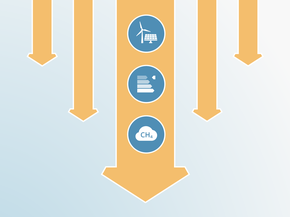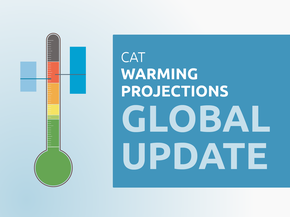Assumptions
Historical emissions
Historical emissions for 1990–2023 are taken from Türkiye’s latest National Inventory Report, submitted to the UNFCCC in 2024 (Republic of Türkiye, 2024).
2030 NDC
The updated NDC of 2023 continues to use the same BAU scenario including LULUCF as the first NDC and INDC (Government of the Republic of Türkiye, 2023). The CAT excludes LULUCF from its calculations. Since the updated NDC does not provide projections for LULUCF, we assume that the LULUCF sink is the same as what is reported in Türkiye’s 5th Biennial Report “With measures” scenario. which corresponded to the mitigation scenario from Türkiye’s first NDC (2021) (Republic of Türkiye Ministry of Environment Urbanisation and Climate Change, 2023). We convert the BAU from GWP AR4 to AR5 using the gas-by-gas breakdown provided in Türkiye’s First Biennial Transparency Report (BTR1). We calculated the new 41% reduction target excluding LULUCF using these values.
Current policy projections
In the assessment from 2023, we used a method for quantifying the current policy projections that relied heavily on the “With Measures” (WM) scenario developed by Türkiye for its 2015 INDC with a historic base year of 2012. In its recently submitted First Biennial Transparency Report (BTR1), Türkiye includes a version of its WM scenario with updated projections, but acknowledges that the mitigation policies and measures used have not changed since the first NDC and INDC (Government of the Republic of Türkiye, 2024). Türkiye is working on updated the WM scenario and is expected to share new projections in its Ninth National Communication and Second Biennial Transparency Report. Therefore, we have once again chosen not to use the WM scenario and instead base our current policy projections on best available sources.
For the upper bound of our current policies projections, we apply the Baseline Scenario’s growth rate for total CO2 from the Istanbul Policy Centre (IPC)’s report “Turkey’s Decarbonization Pathway: Net Zero in 2050” (Şahin et al., 2021). This source provides total emissions, CO2 emissions, and non-CO2 emissions using GWP AR4. To produce a robust upper bound in AR5, we take only the IPC’s CO2 projections for Energy and Industry, harmonised to historical data and extended using growth rates. We then apply growth rates for non-CO2 emissions from the US Environmental Protection Agency’s (US EPA) projections to each non-CO2 gas in energy and industry (U.S. Environmental Protection Agency, 2019). For the agriculture and waste sectors, we apply US EPA’s total non-CO2 growth rate for the respective agriculture and waste sectors to all gases in those sectors in 2022. While the US EPA estimates are for non-CO2 emissions only, the amount of CO2 emitted by the agriculture and waste sectors is so small as to be non-existent, so we use the growth rates for the sector as a whole. Summing these projections produces an upper bound for total emissions in AR5. For the lower bound of our current policies projections, we use total emissions projections from the Global Energy and Climate Outlook (GECO) 2024, produced by the Joint Research Centre of the European Union. Because the data is reported in AR4, we take a gas-by-gas approach, converting each of the non-CO2 gases (CH4, N20, and F-gases) to AR5. Then we harmonise these projections to historical data using the growth rates provided by GECO and sum these together to create a lower bound estimate for Türkiye’s total greenhouse gas emissions.
Net-zero target and other long-term targets
To quantify Türkiye’s 2053 emissions, we assume that Türkiye maintains a LULUCF sink of -70 MtCO2 in 2030 as indicated in its 5th Biennial Report “With Measures” scenario through 2053 (Republic of Türkiye Ministry of Environment Urbanisation and Climate Change, 2023). This means that emissions from all other sectors would need to be reduced to 70 MtCO2 in 2053. As Türkiye’s LTS provides no further clarity on how much of a carbon sink LULUCF is expected to be past 2030, we continue to use this method.
Global warming potentials
The CAT uses Global Warming Potential (GWP) values from the IPCC's Fifth Assessment Report (AR5) for all its figures and time series. Assessments completed prior to June 2025 used GWP values from the Fourth Assessment Report (AR4), and those completed prior to December 2018 (COP24) used GWP values from the Second Assessment report.
Further analysis
Latest publications
Stay informed
Subscribe to our newsletter




